In addition to the usual explanations in terms of resonance or impedance matching, here is a more wordy/graphic physical explanation for why certain lengths are better for both receiving and emitting dipole antenna, without formulae.
For a receiving dipole, we want to achieve as high voltage between the center feeding lines as possible. This voltage isn't directly proportional to external electric field, but, instead, to conservative component of net electric field, which is proportional to degree of separation of charges on the dipole line. Charge density will be oscillating between positive and negative value, and thus we want the highest amplitude of this possible. The higher the current, the higher the charge density amplitude.
For an emitting dipole, to get lots of emitted power, we need lots of charges accelerating in the same direction, in sync. In dipole antenna, this is accomplished by an oscillating electric current which makes charges there to accelerate back and forth (on the diagrams below, left and right). The higher the current, the higher the acceleration.
Thus in both cases, reception and emission, we want to maximize the current amplitudes in the dipole.
Current amplitude can't be the same everywhere in the dipole; it can be large at the center (or in between the center and one end), but it has to be zero at the free ends (because charges usually don't jump out of the conductor end, so current stops there). This means that unless the current is zero everywhere, the current magnitude has to vary along the dipole and decrease to zero near the ends.
If dipole length is close to an integer multiple of $\lambda/2$, the current will oscillate in a standing wave pattern on the dipole, where the free ends are two end nodes of the standing wave.
If dipole length is in between two integer multiples of $\lambda/2$, this prevents such a standing wave, so current makes a more complicated oscillation, possibly with waves running in both directions.
When the antenna is much shorter than $\lambda/2$, it behaves similarly to a capacitor with small capacitance, with current charging and discharging the ends, but being present (and thus charges accelerating) only in a very short piece of conductor. Then, like from a capacitor with oscillating voltage, emission of radiation is very weak.
Increasing the dipole length makes more of the conductor carry the oscillating current, and thus more accelerating charges are present and radiating; this increases emission (assuming current does not change appreciably - but in fact, the current should increase, so emission should increase even more).
When further increasing the length, eventually a special value is reached, close to $\lambda/2$, where the current oscillation achieves a standing wave pattern on the dipole. The current pattern looks like this(the horizontal lines are arms of the dipole, arrows show direction of current, and density of arrows shows amplitude of intensity of current - more arrows, greater amplitude):
-> ->->->-> ->
__________ __________
||
The emission is strongest where the current amplitude is the highest, at the center of the dipole; but all dipole parts, including those near the ends, contribute. In this shortest standing wave, all parts of the dipole still emit in phase, and thus add up constructively.
If we increase the dipole length still more, it is again not possible for the current to oscillate in phase in all parts of the dipole. The dipole is too long - the current wave has half wavelength close to $\lambda/2$ (because it travels in conductor, not in vacuum), so when there is more length available on the dipole arms, somewhere on them, the current has to become zero (zero current) and thus change sign. One part of the dipole then produces radiation electric field with opposite phase (and thus, direction) than the other. These fields, far from the dipole, add up destructively, and net radiation intensity far from the dipole is decreased.
For example, in dipole of length $\lambda$, in one arm of the dipole, current moves towards the center, and in the other half, current moves also towards the center. It looks like this:
-> ->->->-> -> <- <-<-<-<- <-
______________________ ______________________
||
Notice that for every charge accelerating to the right, we have a mirror charge on the other side, accelerating to the left. Their radiation electric fields point in opposite directions, and cancel most of each other, so we get a very decreased emission.
By further increasing the dipole length, the cancellation ceases to be so strong, and emission increases. When we get to $\frac{3}{2}\lambda$, we get yet again a standing wave of current, with two thirds of the dipole having charges accelerating in one direction, and the remaining third having charges accelerating in the opposite direction.
-> ->->->-> -> <- <-<-<-<- <- -> ->->->-> ->
________________________________ ________________________________
||
So emission of the two thirds on the ends will add up constructively, and will be partially cancelled by the center third, but not completely, because a section of a dipole can only cancel radiation of another section of same emission intensity, that is, one third can cancel only one another third. So very approximately, we have emission worth of one dipole third remaining. We could continue increasing the length, and by the same principle, we can expect strong emission for all lengths that are integer multiples of $\lambda/2$, and decreased emission for any lengths in between.
